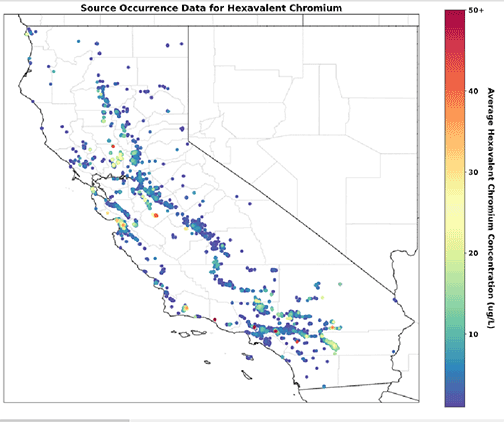On Tuesday, the Brentwood City Council will receive a report on chromium-6 after residents had raised concerns over Chromium-6 levels in the City of Brentwood.
On November 15, 2022, as a Request for Future Agenda Items, Council Members Meyer and
Mendoza requested a future item to discuss community concerns related to possible chromium-
6 in our drinking water.
On December 13, 2022, the City Council directed staff to prepare an informational report on
chromium-6
Chromium
Chromium is a naturally occurring odorless and tasteless mineral found in geologic deposits, particularly in basalts and serpentine rocks. Chromium can be present as pollution in the air in particulate form, usually as very small particles from manmade and natural sources such as cigarette smoke, smelters, windblown soil, and seawater. Chromium is commonly used in producing metal alloys (such as stainless steel), electroplating, tanning, printing, dyeing, glassmaking, and wood preservatives. Manmade processing of chromium is often the source of chromium in environmental waters as well as from leaching from soils. Chromium in natural and manmade compounds can exist in various oxidation states, the most common are chromium-3 (trivalent chromium) and chromium-6 (hexavalent chromium). The oxidation state of chromium can change by manmade and natural processes. While chromium metal and chromium-3 are considered non-toxic, chromium-6 is considered to be toxic and a carcinogen.
Many natural foods (especially meats, mollusks, crustaceans, vegetables and unrefined sugar) contain trace amounts of chromium, primarily as chromium-3. There is international disagreement on whether chromium-3 is an essential nutrient. In 2001, the Food and Nutrition Board of the National Academies of Sciences, Engineering, and Medicine considered it to be an essential nutrient; however, in 2014, the European Food Safety Authority on Dietetic Products, Nutrition and Allergies concluded that no convincing evidence shows that it is essential. Regardless of whether chromium-3 is essential or not, dietary chromium-3 supplements are available for human consumption. According to the National Institute of Health (“NIH”), there are mixed results on whether consuming chromium-3 supplements has beneficial effects on
weight loss, muscle gain, diabetes, metabolic and other ailments.
Chromium-6 is a human carcinogen, as determined by the National Toxicology Program, the International Agency for Research on Cancer, the United States Environmental Protection Agency (“EPA”), and the California Office of Environmental Health Hazard Assessment (“OEHHA”) of the California Environmental Protection Agency (“CalEPA”). According to the National Institute for Occupational Safety and Health (“NIOSH”), Chromium-6 is harmful to the eyes, skin, and respiratory system. Occupational exposure can occur from inhalation of dusts, mists, or fumes containing chromium-6, or from direct eye or skin contact.
The most common forms of chromium that occurs in natural waters in the environment are chromium-3 and chromium-6. Total chromium is the total amount of all forms of chromium, including chromium-3 and chromium-6. Chromium-6 is a strong oxidizing agent and may react with organic matter or other reducing agents to change (or “reduce”) into chromium-3 in water and in soil. In addition, there have been various studies on how chromium-6 reduces to
chromium-3 within the lining of the lungs and in the bloodstream of organisms. Federal Drinking Water Standards
The Safe Drinking Water Act (“SDWA”) requires the EPA to determine the level of contaminants in drinking water at which no adverse health effects are likely to occur. These federal levels are non-enforceable health goals, known as maximum contaminant level goals (“MCLG”), and are based on possible health risks from exposure over a lifetime.
In addition to the health goals, the EPA also sets enforceable standards for drinking water contaminant levels based on the best available science to prevent potential health problems. These enforceable standards are called maximum contaminant levels (“MCL”) which are the maximum permissible levels of a contaminant in a public water system. Federal MCLs are set
as close to the health goals as possible after considering costs, benefits, and the ability of public water systems to detect and remove contaminants using suitable treatment technologies.
In the early 1990’s, the federal MCLG and MCL for total chromium was established at 100 micrograms per 1 liter of water, or 100 parts per billion (“ppb”). As part of their periodic review of drinking water regulations, the EPA initiated a reassessment of the health risks associated with chromium exposure based on new scientific information. In particular, the EPA is working on a risk assessment that includes a comprehensive evaluation of potential health effects associated with both inhalation and ingestion of chromium-6. This assessment of chromium-6 is part of a broad range of chemicals that are evaluated as part of EPA’s Integrated Risk Information System (“IRIS”). Upcoming public events can be found on the IRIS calendar on the following link: https://iris.epa.gov/Events/. Until the EPA finalizes any updates to the drinking
water regulations, the current federal MCLG and MCL for total chromium remains at 100 ppb.
Currently, there are no federal MCLG or MCL established specifically for chromium-6
Staff has contacted the EPA to ask when they expect to issue their final human health assessment for chromium-6, but we have not heard back.
State Drinking Water Standards
Like federal standards, the state also has both non-enforceable health goals, called public health goals (“PHG”), and enforceable standards, also called maximum contaminant levels (“MCL”). The California Safe Drinking Water Act requires a PHG for acutely toxic substances to be set at levels at which no known or anticipated adverse effects on health will occur with an adequate margin of safety.
State drinking water standards are equal to or more stringent than federal standards. Like federal standards, the state is required to establish an MCL at a level as close to the PHG as is technologically and economically feasible. The current state MCL for total chromium is 50 ppb.
In 2011, OEHHA established a chromium-6 PHG of 0.02 ppb. This is estimated to be a de minimus one-in-one-million (1 in 1,000,000) lifetime cancer risk level. This means that for every 1 million people who drink 2 liters of water (with 0.02 ppb of chromium-6) every day for 70 years, no more than one person would expect to develop cancer due to exposure from
chromium-6. As part of the periodic review of PHGs, OEHHA review the PHG from chromium-6 in 2016, and did not make any changes from the 0.02 ppb level.
In 2014, the state MCL for chromium-6 was established at 10 ppb. However, in 2017 the Superior Court of Sacramento County issued a judgement invalidating the MCL level for failure to conduct an economic feasibility analysis for compliance, and ordered the SWRCB to conduct an economic feasibility analysis to reestablish a MCL for chromium-6 with such an analysis.
Since then, the SWRCB has completed the analysis, evaluated a range of possible MCLs from 1 ppb to 25 ppb, and will be considering a chromium-6 MCL of 10 ppb as part of their “rulemaking” process in the coming years. The proposed MCL equates to a lifetime risk for individuals that no more than 1 person out of 2,000 (1 in 2,000) people drinking water at 10 ppb for 70 years may develop cancer due to exposure from chromium-6.
For comparison, below is data of lifetime risk of developing certain types of cancer from the American Cancer Society and the National Cancer Institute’s Surveillance Epidemiology and End Results database:
Males:
- 1 in 2 for any cancer
- 1 in 8 for prostate
- 1 in 16 for lung and bronchus
- 1 in 23 for colon and rectum
- 1 in 28 for bladder
- 1 in 28 for melanoma of the skin
- 1 in 43 for non-Hodgkin lymphoma
- 1 in 44 for kidney and renal pelvis
- 1 in 55 for leukemia
- 1 in 59 for pancreas
- 1 in 60 for oral cavity and pharynx (mouth and throat)
- 1 in 66 for liver and bile duct
- 1 in 102 for stomach
- 1 in 106 for multiple myeloma
- 1 in 128 for esophagus
- 1 in 147 for brain and nervous system
- 1 in 155 for thyroid
- 1 in 200 for larynx (voice box)
- 1 in 246 for testicles
- 1 in 435 for Hodgkin lymphoma
Females:
- 1 in 3 for any cancer
- 1 in 8 for breast
- 1 in 17 for lung and bronchus
- 1 in 26 for colon and rectum
- 1 in 33 for uterus
- 1 in 41 for melanoma of the skin
- 1 in 53 for non-Hodgkin lymphoma
- 1 in 59 for thyroid
- 1 in 61 for pancreas
- 1 in 75 for kidney and renal pelvis
- 1 in 78 for leukemia
- 1 in 88 for ovary
- 1 in 91 for bladder
- 1 in 134 for multiple myeloma
- 1 in 141 for oral cavity and pharynx
- 1 in 146 for liver and bile duct
- 1 in 153 for cervix
- 1 in 157 for stomach
- 1 in 188 for brain and nervous system
- 1 in 439 for esophagus
- 1 in 532 for Hodgkin lymphoma
- 1 in 852 for larynx (voice box)
The State Water Resources Control Board (“SWRCB”) Division of Drinking Water’s water quality
database reported findings of chromium-6 from 2012 to 2022. The map below showing 7780
sources with average concentrations at least 1 ppb

The SWRCB has tentatively analyzed three proposed best available treatment technologies for the removal of chromium-6 from drinking water to concentrations at or below the proposed MCL of 10 ppb: reduction coagulation filtration, ion exchange, and reverse osmosis. More information about these technologies and associated costs can be found at the below link for the SWRCB Proposed Hexavalent Chromium MCL Staff Report.
Brentwood Water
In 2021, 3.11 billion gallons (83%+/-) of Brentwood’s drinking water came from treated surface water supplies and the remaining 0.62 billion gallons (17%+/-) came from wells. In addition, 320 million gallons of recycled water from the wastewater treatment plant plus 169 million gallons from untreated surface water was used to irrigate some of our school fields, parks and roadway landscaping. Total chromium was not detected in our surface water supplies, and total
chromium levels ranged between 4.7 ppb and 8.9 ppb from our wells.
In late 2022, City staff collected water samples and obtained the following results specifically for chromium-6:
- Surface water treatment plant: No Detect (<0.0079 ppb)
- Water wells: Ranged from 4.6 to 6.7 ppb
- Recycled water: 0.18 ppb
- Wastewater influent: No Detect (<0.0079 ppb)
Summary
The City takes public health and safety concerns seriously, including concerns related to water quality. The City currently meets or exceeds all federal and state requirements for drinking water, including for total chromium. We will continue to monitor both federal and state efforts to update water quality standards, including for chromium-6, and update our water quality testing and reporting as necessary.
If anyone has any concerns or questions about the City’s water quality, they should contact the Public Works Department at 925-516-6000.
Brentwood City Council Meeting
February 28, 2023 at 7:00 pm
50 City Park Way, Brentwood CA
City Council Agenda – click here

